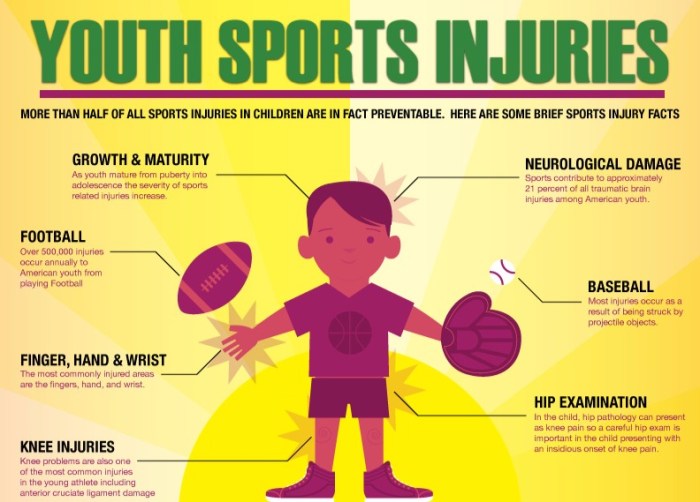Sports injury prevention is a game-changer, yo! From avoiding those nasty sprains to keeping athletes at the top of their game, let’s dive into the strategies and techniques that make all the difference.
Get ready to learn about the crucial aspects of preventing sports injuries and how it impacts an athlete’s performance and career.
Importance of Sports Injury Prevention
Preventing sports injuries is crucial for athletes to maintain their performance and long-term health. By taking proactive steps to prevent injuries, athletes can minimize their risk of setbacks and stay in top physical condition.
Examples of Common Sports Injuries that Can be Prevented
- A sprained ankle: Proper warm-up and conditioning exercises can help strengthen the muscles and ligaments around the ankle, reducing the risk of sprains.
- Tennis elbow: Using the correct technique and equipment, as well as incorporating strengthening exercises for the forearm muscles, can prevent this overuse injury.
- ACL tear: Maintaining proper form during movements and incorporating exercises to strengthen the muscles around the knee can help prevent this serious injury.
Impact of Sports Injuries on an Athlete’s Performance and Career
Sports injuries can significantly impact an athlete’s performance and career trajectory. Not only do injuries lead to time off from training and competition, but they can also result in long-term consequences such as chronic pain or decreased mobility. Athletes who repeatedly suffer from injuries may struggle to reach their full potential and may face challenges in advancing their careers.
Strategies for Sports Injury Prevention
Proper warm-up and cool-down routines are crucial in preventing sports injuries. These routines help prepare the body for physical activity and aid in recovery post-exercise.
Importance of Strength and Conditioning Training
Strength and conditioning training play a significant role in injury prevention by helping athletes build muscle strength, endurance, and overall fitness. This type of training can improve stability and balance, reducing the risk of injuries during sports activities.
Role of Flexibility and Mobility Exercises
Flexibility and mobility exercises are essential for preventing sports injuries as they help improve range of motion, reduce muscle tightness, and enhance joint flexibility. By incorporating these exercises into a regular routine, athletes can decrease the likelihood of strains, sprains, and other common injuries.
Common Sports Injury Prevention Techniques

When it comes to preventing sports injuries, there are several techniques that athletes can utilize to stay safe and perform at their best.
RICE Method for Treating Acute Injuries
The RICE method is a common approach used to treat acute injuries:
- Rest: It is essential to give the injured area proper rest to allow for healing.
- Ice: Applying ice to the injured area can help reduce swelling and inflammation.
- Compression: Using compression bandages can provide support and reduce swelling.
- Elevation: Elevating the injured area above the heart can help reduce swelling and promote healing.
Significance of Proper Gear and Equipment
Using the right gear and equipment is crucial in preventing sports injuries:
- Wearing appropriate footwear can provide stability and support, reducing the risk of ankle and foot injuries.
- Protective gear such as helmets, pads, and mouthguards can help prevent head, joint, and dental injuries.
Techniques for Specific Sports
For injury prevention in specific sports, techniques like taping, bracing, and padding can be beneficial:
- In basketball, athletes often use ankle braces to prevent sprains, while volleyball players may benefit from knee pads to protect against impact injuries.
- Football players commonly wear shoulder pads and helmets to reduce the risk of shoulder and head injuries during tackles.
Importance of Rest and Recovery
Rest and recovery play a crucial role in preventing overuse injuries in athletes. When the body is pushed to its limits through intense physical activity, it needs time to repair and rebuild in order to perform at its best and avoid potential injuries.
Role of Sleep, Hydration, and Nutrition
- Sleep: Adequate sleep is essential for the body to recover and repair muscles. During sleep, the body releases growth hormone, which aids in muscle repair and growth.
- Hydration: Staying properly hydrated is key to replenishing lost fluids during exercise. Dehydration can lead to muscle cramps and fatigue, increasing the risk of injury.
- Nutrition: Eating a balanced diet rich in nutrients helps the body recover faster and maintain overall health. Consuming protein after workouts can help repair and build muscle tissue.
Effective Rest and Recovery Strategies
- Active Recovery: Engaging in light physical activity such as stretching or yoga on rest days can help improve blood flow and reduce muscle soreness.
- Foam Rolling: Using a foam roller can help release muscle tension and improve flexibility, aiding in the recovery process.
- Ice Baths: Cold therapy can help reduce inflammation and muscle soreness, promoting faster recovery after intense workouts.
- Massage Therapy: Regular massages can help improve circulation, reduce muscle tension, and speed up the healing process.
Injury Prevention Programs

Injury prevention programs are essential for athletes to reduce the risk of injuries and improve their overall performance on the field. These programs typically consist of various components that focus on strengthening, flexibility, and conditioning to help athletes stay healthy throughout the season.
Components of a Comprehensive Injury Prevention Program
- Warm-up and cool-down routines to prepare the body for physical activity and aid in recovery.
- Strength training exercises to build muscle and support joints, reducing the risk of strains and sprains.
- Flexibility exercises to improve range of motion and prevent muscle imbalances that can lead to injuries.
- Balance and coordination drills to enhance proprioception and stability, reducing the risk of falls and twists.
- Proper technique training to ensure athletes perform movements correctly and avoid unnecessary stress on the body.
Benefits of Pre-season Screenings and Assessments
Pre-season screenings and assessments play a crucial role in identifying potential risk factors for injuries before the season begins. By evaluating athletes’ physical condition, movement patterns, and previous injury history, coaches and trainers can develop personalized injury prevention programs tailored to each individual’s needs. This proactive approach not only helps in reducing the likelihood of injuries but also enhances performance and longevity in sports.
Tailoring Injury Prevention Programs to Specific Sports and Athletes, Sports injury prevention
Injury prevention programs can be customized based on the demands of a particular sport and the unique characteristics of each athlete. For example, a basketball player may focus on exercises that improve vertical jump and agility, while a soccer player may emphasize drills that enhance speed and endurance. By understanding the specific requirements of the sport and the individual strengths and weaknesses of athletes, coaches can design targeted programs that address potential areas of vulnerability and optimize performance on the field.
